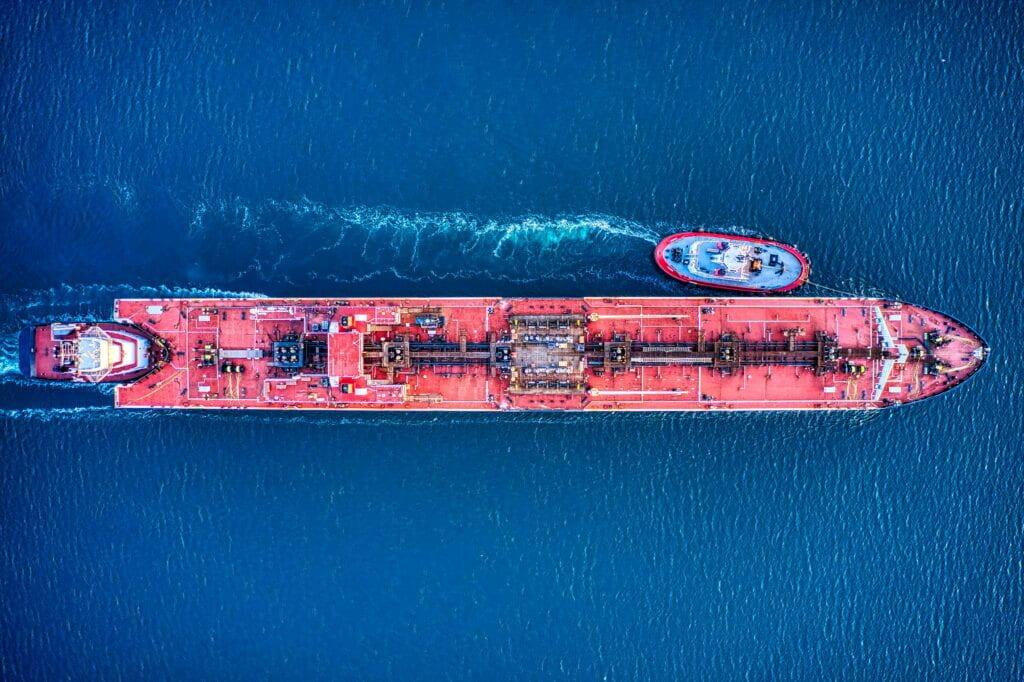by Raghvendra Kumar, PhD.

The security of the maritime flow of petroleum-based energy will be a critical determinant for both New Delhi and Beijing, while India’s geographical proximity to the source of oil and gas exporting countries will always provide India and its Navy with an upper hand to exploit Beijing’s security-of-energy vulnerability. (Photo Source: Venti Views on Unsplash).
India and China are net importers of oil and gas and are heavily dependent on overseas energy supplies for their sustained economic expansion and development. They import oil and gas from various geographical regions, including countries from West Asia, Africa, and South America. The critical commodities sourced from the hydrocarbon resource-rich regions of West Asia and Africa are of significant value to India and China, “as these two regions alone accounted for 64.5% and 63% of oil imports, respectively, in 2022” (Economic Times & U.S. Energy Information Administration, 2022). However, the increased flow of cheap oil from Russia in the aftermath of the Ukraine conflict has become a lucrative alternative to West Asia, Africa, and South America in China’s energy security matrix.
However, replacing West Asia, Africa, and South America as the primary suppliers of oil to China requires three factors, according to scholarly analysis. First, the share of renewable energy sources should overtake conventional sources in China’s energy mix. The share of renewable sources of energy in India’s and China’s energy mix is bound to rise at a decent pace. Both India and China have set ambitious renewable energy targets, with India aiming to achieve 450 gigawatts (GW) of renewable energy capacity by 2030, including 280 GW of solar energy and 140 GW of wind energy, while China targets to increase its non-fossil fuel energy consumption to 25% and reduce its carbon dioxide emissions by 2030 (Economic Times, & U.S. Energy Information Administration, 2022). Despite significant progress in the cost of production and feasibility, the limitations on renewable energy’s widespread utility, availability, adoption and efficiency remind us how dependent the world is on fossil fuel —especially oil and gas. Second, a significant increase in the share of natural gas in China’s energy mix could end its dependence on oil, allowing huge volumes of gas to be imported through pipelines from gas-rich areas of Central Asia and Russia. China “currently consumes around 13.4 million barrels per day (b/d)” (Reuters, 2022) and “imports 11.8 million b/d” (Reale, Bingham, and Greenberg, 2), of which only a fraction is transported through pipelines. Further, the adaptation of China’s national industry to a gas-based economy is possible but will not be swift as it faces several hurdles. Firstly, significant investment in infrastructure like pipelines and storage facilities is needed, demanding time for planning and implementation. Secondly, technological challenges in altering industrial processes from oil and coal to natural gas are prominent. Thirdly, resistance from existing industries and stakeholders poses a barrier to change. Lastly, economic factors, including costs and potential disruptions, need careful management. Overall, the transition is expected to be gradual due to these complexities. Consequently, reliance on oil will be critical for China for a foreseeable period.
The third factor addresses the practicality and affordability of alternative maritime routes, such as the Northern Sea Route (NSR), which is questionable considering China’s security-of-energy strategy. The NSR constitutes a vital maritime corridor connecting Europe and Asia via the northern regions of Russia. The “NSR is the shortest route linking Europe to East and South East Asia,” and, “until the 20th century, due to its harsh icebound environment, oceanographic ships conducting surveys were the primary users, but the ice-free period in summer has become longer every year, making it the better condition for sailing” (Hataya and Huang, 4). This renewed attention is primarily driven by the potential for extended navigational periods and the resultant cost and time reductions associated with utilizing these emerging shipping lanes. The all-weather accessibility of NSR due to adverse impacts of climate change could provide an indisputable advantage over the conventional route passing through the Indian Ocean via the choke points of the Suez Canal, Bab-el-Mandeb and Malacca strait to Beijing as an alternative sea route. However, in comparison to other sea routes, the NSR is still underdeveloped (The Japan Association of Marine Safety, 2016). It poses several limitations, including a lack of specialised tanker fleets, equipment, and supporting infrastructure, hindering its wider suitability because the Northern Sea is comparatively more vulnerable to environmental factors than the Indian Ocean, “especially during winters” (United States Coast Guard, 6). Therefore, since the relevance of crude oil and natural gas is not going to diminish in the strategic calculations of India and China, the centrality of the Persian Gulf remains crucial.
The pivotal role of West Asia and Africa in India (the world’s third-largest consumer and importer of oil) and China (the world’s largest consumer and importer of oil) is sure to intensify as their future demand for overseas oil and gas is expected to rise at a significant pace due to their “rapid rate of growth and development and increased per capita demand” (The Institute of Energy Economics, Japan (IEEJ) 8). By 2050, the share of oil and gas will be around 32% (International Energy Agency 2019) in China’s and 39% (BP 2023) in India’s total energy mix, a projection that challenges the conventional assumption that renewable sources of energy will undermine the importance of oil and gas. This continued centrality of West Asia, Africa and South America in Beijing’s and New Delhi’s security-of-energy is primarily determined by geography. Oil coming from Venezuela on Very Large Crude Carriers (VLCCs) that draw too much water cannot maneuver the shallow depths of the Panama Canal and, therefore, must sail almost halfway around the world to reach India and China. Similarly, oil from Nigeria, Libya, Angola, and rest of Africa must either pass from the Suez Canal or through the Cape of Good Hope, whereas the oil from the Persian Gulf has to pass through the choke point of the Strait of Hormuz, situating India and China on the same plane of geographical vulnerability. However, New Delhi gains a comparative advantage due to its central location in the Indian Ocean Region (IOR), close to the primary sources (West Asia and Africa) from where it imports the majority of its oil and gas. However, this becomes a critical vulnerability for China, which has no direct access to the IOR. China imports “nearly 75% of its oil from abroad,” most of which is imported from a single geographical region, the Persian Gulf (Government of China, 2022). The Persian Gulf is separated from the east coast of China by two major natural choke points, the Strait of Hormuz and the Strait of Malacca.
China’s vulnerability is demonstrated by the close proximity of the Indian island territories of Andaman and Nicobar to the Strait of Malacca, while the Persian Gulf, Gulf of Aden, and the East African Coast are near India’s western seaboard. This gives New Delhi substantial influence over vital sea lines of communication (SLOCs) that carry the bulk of China’s oil and other merchandise trade. Therefore, by virtue of geographical positioning, New Delhi and its Navy is in a commanding position to control the China-bound maritime movement of oil and gas. The Indian Navy’s sustained presence through its mission-based deployments around the Persian Gulf, Gulf of Oman, Gulf of Aden, the Mozambique Channel, and its strategic approaches to the Straits of Malacca, Sunda, Lombok and Ombai-Wetar, Central and South Indian Ocean provides it with strategic depth to counter several contingencies that may arise. These deployments enable New Delhi to easily interdict China-bound oil, causing anxiety in Beijing and further amplifying its vulnerability.
China, in order to circumvent the vulnerability of its energy systems, is investing heavily in its Belt and Road Initiatives (BRI) and expanding the People’s Liberation Army (PLA) Navy’s role and presence in the IOR. In the past decade, “China, through its BRI project in Pakistan, aims to invest approximately US$ 62 billion” (Brookings Institution, 2020) in the China-Pakistan Economic Corridor (CPEC), which passes through Pakistan-occupied Kashmir (PoK). The Chinese strategic community views the CPEC as a means to promote the idea that Gwadar port will serve as a bypass to the Strait of Malacca. However, in order for this to be possible, two factors should be taken into account. First, to transport the bulk of West Asian oil to China through a series of pipelines, one must account for the elevation from Gwadar, a port city in the Baluchistan province of Pakistan, to Kashgar in the Xinjiang province of China, which sits at an elevation of approximately 1500 meters. However, this route passes through Gilgit-Baltistan, “which is part of the Kashmir region under illegal occupation by Pakistan” (MEA 2020), and “includes the highest point, Khunjerab Pass, at roughly 4500 meters elevation” (South China Morning Post n.d.). This disputed territory, coupled with the high elevation, would pose significant challenges. Therefore, transporting oil through pipelines as a solution to China’s problem is neither feasible nor cost-effective. A second option for China to bypass the Malacca Strait would be through a network of highways and rail links – which also happens to be one of the major thrust areas of CPEC. Despite Gwadar’s “strategic positioning” at the mouth of the Persian Gulf, which can facilitate the movement of the bulk of China’s oil, the depth of the Gwadar port becomes the most significant limitation. Due to siltation, the port requires dredging of the approach channels at regular intervals to “increase the depth to 14 metres from the current 11.5 metres” (The Nation, 2022). In order to enable the docking of ships with a deadweight tonnage (DWT) of up to 70,000 DWT, while the “current capacity permits a maximum of 20,000 DWT” (Kardon, Kennedy, and Dutton, 13). This makes the process expensive and limits its practical usage by bulk oil carriers. Further, the lack of capacity and requisite infrastructure to offload the VLCC is another aspect that limits the use of Gwadar Port as an alternative route to the Strait of Malacca.
In comparison, India’s strategic position at the intersection of international shipping lanes entitles New Delhi and its Navy to effectively and efficiently use hard power tools to interdict China’s oil supply, crippling its economy. China is aware of its comparative disadvantage manifested by the ‘harness of geography.’ This geographical reality is at the cusp of its strategic and operational planning as it sees the Indian Navy as a threat in its security dilemma. Thus, the uninterrupted supply of oil and gas at an affordable price is critical to India’s and China’s national security as their societal and economic well-being is entwined with unhindered access to these critical commodities.
In conclusion, despite the desire and efforts undertaken to transition away from fossil fuels — oil and gas will remain dominant in India’s and China’s energy mix. They will continue to consume significant amounts of oil and gas to meet their growing economic and per capita demand. In this context, the security of the maritime flow of petroleum-based energy will be a critical determinant for both New Delhi and Beijing while India’s geographical proximity to the source of oil and gas exporting countries will always provide it and its Navy an upper hand to exploit Beijing’s security-of-energy vulnerability.
*******
Dr. Raghvendra Kumar holds a PhD in African Studies from the University of Delhi, specializing in Indian Ocean geopolitics and India’s and China’s involvement in East African Island States. Previously, he served as an Associate Fellow at the National Maritime Foundation (NMF) in New Delhi. Before his tenure at NMF, he taught undergraduate students at the Department of Political Science, Maharaja Agrasen College, University of Delhi, India. He can be reached at raghvendrakumar2007@gmail.com.
Acknowledgements:
The author would like to express sincere gratitude to Vice Admiral Pradeep Chauhan, DG, NMF, for his invaluable feedback and insights provided to the author during his tenure as an Associate Fellow at the NMF. His expertise and guidance significantly contributed to the refinement of this research paper.
Works Cited
BP. “India Insights.” BP Energy Outlook, 2023. www.bp.com/en/global/corporate/energy-economics/energy-outlook/country-and-regional-insights/india-insights.html. Accessed 23 September 2023.
Brookings Institution. “China-Pakistan Economic Corridor.” The Brookings Institution, 15 June 2020. www.brookings.edu/wp-content/uploads/2020/06/FP_20200615_china_pakistan_afzal_v2.pdf. Accessed 21 September 2023.
Economic Times. “India’s Russian Oil Binge Drags Down Opec’s Share to Lowest in 2022.” The Economic Times, 23 Aug. 2022. economictimes.indiatimes.com/markets/commodities/news/indias-russian-oil-binge-drags-down-opecs-share-to-lowest-in-2022/articleshow/97065032.cms. Accessed 19 September 2023.
Government of China. “A Report on the Work of the Government (2022).” English.www.gov.cn, 24 Feb. 2022. english.www.gov.cn/news/topnews/202202/24/content_WS6216e221c6d09c94e48a569e.html. Accessed 23 September 2023.
Hataya, Sakiko, and Huang, Michael C. “The Opportunity and Challenges of the Northern Sea Route (NSR) after the Suez Obstruction of 2021.” OPRI Perspectives No.22 [2021], SPF (Sasakawa Peace Foundation) Ocean Policy Research Institute, p. 4, https://www.spf.org/opri-intl/global-data/report/perspectives/20210804165958118.pdfAccessed 24 September 2023.
Kardon, Isaac B., Conor M. Kennedy, and Peter A. Dutton. “China Maritime Report No. 7: Gwadar: China’s Potential Strategic Strongpoint in Pakistan.” 2020. CMSI China Maritime Reports, no. 7. Digital Commons, US Naval War College. https://digital-commons.usnwc.edu/cmsi-maritime-reports/7. Accessed 8 March 2024.
Ministry of External Affairs (MEA) “QUESTION NO.606: BRI AND CPEC.” Ministry of External Affairs, Government of India, February 05, 2020. www.mea.gov.in/lok-sabha.htm?dtl/32353/QUESTION+NO606+BRI+AND+CPEC. Accessed 8 March 2024.
The Institute of Energy Economics, Japan (IEEJ). “China Energy Outlook 2050.” CNPC ETRI, 2018, eneken.ieej.or.jp/data/8192.pdf. pp 1-58. Accessed 24 September 2023.
International Energy Agency. “2050 World and China Energy Outlook 2019.” ResearchGate, 2019,www.researchgate.net/publication/345151631_2050_World_and_China_Energy_Outlook_2019. Accessed 20 September 2023.
Reale, Hannah, Emma Bingham, and Kara Greenberg. “Where Does China Get Its Oil?” The Wire China, 12 July 2020. www.energypolicy.columbia.edu/sites/default/files/file-uploads/Where%20Does%20China%20Get%20Its%20Oil_%20-%20The%20Wire%20China.pdf. Accessed 19 September 2023.
Reuters. “China’s Re-Opening J-Curve: Oil Consumption.” Reuters, 13 Dec. 2022, www.reuters.com/markets/commodities/chinas-re-opening-j-curve-oil-consumption-2022-12-13/. Accessed 19 September 2023.
South China Morning Post. “Pakistan’s Gwadar Port Is the Jewel in the Crown of China’s One Belt One Road Initiative.” South China Morning Post, multimedia.scmp.com/news/china/article/One-Belt-One-Road/pakistan.html.
The Japan Association of Marine Safety. “Northern Sea Route Handbook”. https://www.nikkaibo.or.jp/pdf/NorthernSeaRouteHandbook_E.pdf. Accessed 20 September 2023.
The Nation. “Depth of Gwadar Deep Sea Port Reduces to 11 Meters Due to Siltation.” The Nation, 13 May 2022, www.nation.com.pk/13-May-2022/depth-of-gwadar-deep-sea-port-reduces-to-11-meters-due-to-siltation. Accessed 25 September 2023.
U.S. Energy Information Administration. “China.” U.S. Energy Information Administration, Jan. 2022. ww.eia.gov/international/content/analysis/countries_long/China/china.pdf. Accessed 19 September 2023.
United States Coast Guard. “Arctic Search and Rescue.” Department of Homeland Security, 2020 https://www.dhs.gov/sites/default/files/publications/USCG%20-%20Arctic%20Search%20and%20Rescue_1.pdf. Accessed 20 September 2023.

 The startling rise of populism in the West has resulted in nothing short of cultural upheaval. In the US and the UK, a unique breed of demagogues has surged to power, manipulating exclusivist identities to polarize and consolidate control. How has identity become a political weapon, and how might we return to mutual understanding? (Photo credit: Hello I’m Nik on Unsplash)
The startling rise of populism in the West has resulted in nothing short of cultural upheaval. In the US and the UK, a unique breed of demagogues has surged to power, manipulating exclusivist identities to polarize and consolidate control. How has identity become a political weapon, and how might we return to mutual understanding? (Photo credit: Hello I’m Nik on Unsplash)


